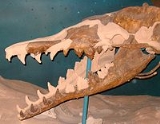
List of extinct cetaceans
Encyclopedia
The list of extinct cetaceans features the extinct
genera
and species
of the order Cetacea
. The cetaceans (whale
s, dolphin
s and porpoise
s) are descendants of land-living mammals, the even-toed ungulate
s. The earliest cetaceans were still hoofed-mammals. These early cetaceans became gradually better adapted for swimming than for walking on land, finally evolving
into fully marine cetaceans.
This list currently includes only fossil
genera and species. However, the Atlantic
population of Gray Whale
s (Eschrichtius robustus) was hunted to extinction in the 17th century, and the Baiji
(or Chinese River Dolphin, Lipotes vexillifer) was declared "functionally extinct" after an expedition in late 2006 failed to find any in the Yangtze River
.
Family Ambulocetidae
(Eocene)

Family Basilosauridae
(Late Eocene)
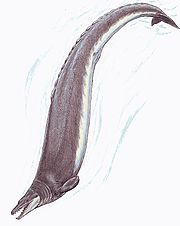
Family Pakicetid
(Early to Middle Eocene)

Family Protocetidae
(Eocene)
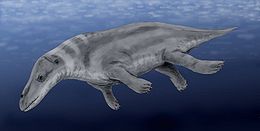
Family Remingtonocetidae
(Eocene)

Family Balaenidae
(Oligocene to Recent)
Family Cetotheriidae
(Miocene - Early Pleistocene)

Family Eschrichtiidae
(Miocene to Recent)
Gricetoides
Megapteropsis
Family Mammalodontidae
(jr synonym Janjucetidae)
 (Late Oligocene)
(Late Oligocene)
Family Pelocetidae
(Miocene)
Family incertae sedis
Family Eurhinodelphinidae
(Mid Miocene to Pliocene)
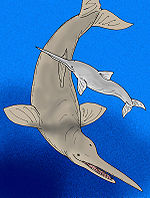
Family Kentriodontidae
(Late Oligocene - Middle Miocene)
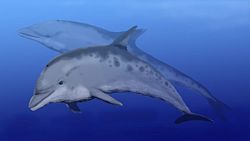
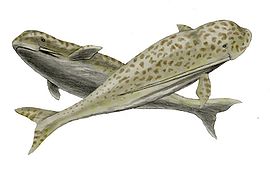
Family incertae sedis
Extinction
In biology and ecology, extinction is the end of an organism or of a group of organisms , normally a species. The moment of extinction is generally considered to be the death of the last individual of the species, although the capacity to breed and recover may have been lost before this point...
genera
Genera
Genera is a commercial operating system and development environment for Lisp machines developed by Symbolics. It is essentially a fork of an earlier operating system originating on the MIT AI Lab's Lisp machines which Symbolics had used in common with LMI and Texas Instruments...
and species
Species
In biology, a species is one of the basic units of biological classification and a taxonomic rank. A species is often defined as a group of organisms capable of interbreeding and producing fertile offspring. While in many cases this definition is adequate, more precise or differing measures are...
of the order Cetacea
Cetacea
The order Cetacea includes the marine mammals commonly known as whales, dolphins, and porpoises. Cetus is Latin and is used in biological names to mean "whale"; its original meaning, "large sea animal", was more general. It comes from Ancient Greek , meaning "whale" or "any huge fish or sea...
. The cetaceans (whale
Whale
Whale is the common name for various marine mammals of the order Cetacea. The term whale sometimes refers to all cetaceans, but more often it excludes dolphins and porpoises, which belong to suborder Odontoceti . This suborder also includes the sperm whale, killer whale, pilot whale, and beluga...
s, dolphin
Dolphin
Dolphins are marine mammals that are closely related to whales and porpoises. There are almost forty species of dolphin in 17 genera. They vary in size from and , up to and . They are found worldwide, mostly in the shallower seas of the continental shelves, and are carnivores, mostly eating...
s and porpoise
Porpoise
Porpoises are small cetaceans of the family Phocoenidae; they are related to whales and dolphins. They are distinct from dolphins, although the word "porpoise" has been used to refer to any small dolphin, especially by sailors and fishermen...
s) are descendants of land-living mammals, the even-toed ungulate
Even-toed ungulate
The even-toed ungulates are ungulates whose weight is borne about equally by the third and fourth toes, rather than mostly or entirely by the third as in odd-toed ungulates such as horses....
s. The earliest cetaceans were still hoofed-mammals. These early cetaceans became gradually better adapted for swimming than for walking on land, finally evolving
Evolution of cetaceans
The cetaceans are marine mammal descendants of land mammals. Their terrestrial origins are indicated by:* Their need to breathe air from the surface;* The bones of their fins, which resemble the limbs of land mammals...
into fully marine cetaceans.
This list currently includes only fossil
Fossil
Fossils are the preserved remains or traces of animals , plants, and other organisms from the remote past...
genera and species. However, the Atlantic
Atlantic Ocean
The Atlantic Ocean is the second-largest of the world's oceanic divisions. With a total area of about , it covers approximately 20% of the Earth's surface and about 26% of its water surface area...
population of Gray Whale
Gray Whale
The gray whale, Eschrichtius robustus, is a baleen whale that migrates between feeding and breeding grounds yearly. It reaches a length of about , a weight of , and lives 50–70 years. The common name of the whale comes from the gray patches and white mottling on its dark skin. Gray whales were...
s (Eschrichtius robustus) was hunted to extinction in the 17th century, and the Baiji
Baiji
Baiji may refer to:* The Baiji or Yangtze River Dolphin * Baiji, Iraq, a city of northern Iraq.* "Baiji" is the pinyin Romanization for Baekje....
(or Chinese River Dolphin, Lipotes vexillifer) was declared "functionally extinct" after an expedition in late 2006 failed to find any in the Yangtze River
Yangtze River
The Yangtze, Yangzi or Cháng Jiāng is the longest river in Asia, and the third-longest in the world. It flows for from the glaciers on the Tibetan Plateau in Qinghai eastward across southwest, central and eastern China before emptying into the East China Sea at Shanghai. It is also one of the...
.
Family AmbulocetidaeAmbulocetidaeAmbulocetidae is a family of early cetaceans from Pakistan that still were able to walk on land. The genus Ambulocetus, after which the family is named, is by far the most complete and well-known ambulocetid genus due to the discovery by Thewissen et al. of a partially complete specimen of...
(Eocene)
- AmbulocetusAmbulocetusAmbulocetus was an early cetacean that could walk as well as swim. It lived during early Eocene some 50-49 million years ago. It is a transitional fossil that shows how whales evolved from land-living mammals. The Ambulocetus fossils were found in Pakistan by anthropologist Johannes Thewissen...
- HimalayacetusHimalayacetusHimalayacetus is an extinct genus of carnivorous aquatic mammal of the family Ambulocetidae from the coastline of the ancient Tethys Ocean during the Eocene, living from 55.8—48.6 mya, existing for approximately ....
- GandakasiaGandakasiaGandakasia was a genus of ambulocetid from Pakistan, that lived in the Eocene epoch. It probably caught its prey near rivers or streams....
Family BasilosauridaeBasilosauridaeBasilosauridae is family of extinct cetaceans that lived in tropical seas during the late Eocene.-Taxonomy:*Family Basilosauridae** Subfamily Basilosaurinae*** Genus Basilosaurus*** Genus Basiloterus** Subfamily Dorudontinae...
(Late Eocene)
-
- BasilosaurinaeBasilosaurinaeBasilosaurinae is a subfamily of cetaceans archaeocetes containing two genera: Basilosaurus and Basiloterus. Were characterized by elongated distal thoracic vertebrae, lumbar, and proximal sacrococcygeal...
- BasilosaurusBasilosaurusBasilosaurus is a genus of cetacean that lived from in the Late Eocene. Its fossilized remains were first discovered in the southern United States . The American fossils were initially believed to be some sort of reptile, hence the suffix -"saurus", but later found to be a marine mammal...
- Basiloterus
- Basilosaurus
- DorudontinaeDorudontinaeDourdontinae are a group of extinct cetaceans that are related to Basilosaurus.- Classification :*Subfamily Dorudontinae** Genus Ancalecetus*** Ancalecetus simonsi** Genus Chrysocetus*** Chrysocetus healyorum...
- AncalecetusAncalecetusAncalecetus is an extinct genus of whale....
- ChrysocetusChrysocetusChrysocetus is an genus of extinct whale....
- CynthiacetusCynthiacetusCynthiacetus is an extinct genus of cetacean archaeocete, belonging to the family Basilosauridae. Lived during the Upper Eocene 38 million years ago. Was found in the southeastern United States, Egypt and Peru. Its skull was similar in size and morphology to Basilosaurus, but unlike it had no...
- DorudonDorudonDorudon was a genus of ancient cetacean that lived alongside Basilosaurus 41 to 33 million years ago, in the Eocene. They were about five meters long and were most likely carnivorous, feeding on small fish and mollusks. Dorudontines lived in warm seas around the world...
- SaghacetusSaghacetusSaghacetus is a extinct genus of cetacean archaeocete, belonging to the family Basilosauridae. Existed during the Upper Eocene in Egypt....
- ZygorhizaZygorhizaZygorhiza kochii is an extinct species of cetacean.Zygorhiza was a smaller, less elongated, 6 m long relative of the famous Basilosaurus. Its bodily proportions were similar to those of modern whales, although, unlike modern species, it had a distinct neck, and flippers which could be moved at...
- Ancalecetus
- Kekenodontinae
- Kekenodon
- Phococetus
- Stromeriinae
- Stromerius
- Basilosaurinae
Family PakicetidPakicetidPakicetids or Pakicetidae are a carnivorous mammal family of the suborder Archaeoceti which lived during the Early Eocene to Middle Eocene in Pakistan and existed for approximately ....
ae
(Early to Middle Eocene)
- GandakasiaGandakasiaGandakasia was a genus of ambulocetid from Pakistan, that lived in the Eocene epoch. It probably caught its prey near rivers or streams....
- PakicetusPakicetusPakicetus is a genus of extinct terrestrial carnivorous mammal of the family Pakicetidae which was endemic to Pakistan from the Eocene .Pakicetus existed for approximately...
- NalacetusNalacetusNalacetus is an extinct genus of mammal belonging to the family Pakicetidae which were endemic to southern Asia living during the Lutenian stage of the Middle Eocene and existing for approximately ....
- IchthyolestesIchthyolestesIchthyolestes was a genus of mammal belonging to the family Pakicetidae which were endemic to southern Asia living during the Lutenian stage of the Middle Eocene and existing for approximately ....
Family ProtocetidaeProtocetidaeThe protocetids form a diverse and heterogeneous group of cetaceans known from Asia, Europe, Africa, and North America. There were many genera, and some of these are very well known . Known protocetids had large fore- and hindlimbs that could support the body on land, and it is likely that they...
(Eocene)
- Georgiacetinae
- Babiacetus
- Carolinacetus
- Eocetus
- GeorgiacetusGeorgiacetusGeorgiacetus is an extinct genus of ancient whale known from the Eocene period of the United States.At Georgia Southern University there is a Georgiacetus skeleton on display at the campus museum.- References :...
- Natchitochia

- Pappocetus
- Makaracetinae
- Makaracetus
- Protocetinae
- ArtiocetusArtiocetusArtiocetus clavis is an extinct genus of early whales belonging to the family Protocedidae. Their name arises from a combination of Cetacean and Artiodactyl, as this fossil was the first to show that early whales possessed artiodactyl-like ankles....
- Crenatocetus
- GaviacetusGaviacetusGaviacetus was a primitive cetacean that lived approximately 45 million years ago. Although often represented as having small hind limbs, this is an inference from the general progression of other fossil species towards limb loss; the only postcranial remains found for Gaviacetus itself were a rib...
- Indocetus
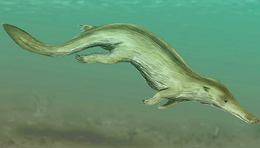
- MaiacetusMaiacetusMaiacetus is a genus of early middle Eocene cetacean from Pakistan.-Paleobiology:The genus contains a single species Maiacetus inuus, first described in 2009 on the basis of two specimens, including a specimen which has been interpreted as a pregnant female and its fetus...
- ProtocetusProtocetusProtocetus atavus is an extinct species of primitive cetacean from Egypt. It lived during the middle Eocene period 45 million years ago....
- Qaisracetus
- RodhocetusRodhocetusRodhocetus is one of several extinct whale genera that possess land mammal characteristics, thus demonstrating the evolutionary transition from land to sea.-Description:...
- TakracetusTakracetusTakracetus was a primitive cetacean that lived approximately 45 million years ago. The type specimen was a partial skull though the literature mentions a second more complete skeleton....
- Artiocetus
Family RemingtonocetidaeRemingtonocetidaeRemingtonocetidae is a family of early carnivorous freshwater aquatic mammals of the order Cetacea endemic to the coastline of the ancient Tethys Ocean during the Eocene living from 55.8—48.6 mya, existing for approximately ....
(Eocene)
- Andrewsiphius
- AttockicetusAttockicetusAttockicetus is an extinct genus of cetacean which existed in Pakistan during the Eocene period. The type species is Attockicetus praecursor....
- DalanistesDalanistesDalanistes is an extinct genus of early carnivorous freshwater aquatic mammals of the family Remingtonocetidae endemic to the coastline of the ancient Tethys Ocean during the Eocene living from 48.6—37.2 mya, existing for approximately .-Taxonomy:...
- KutchicetusKutchicetusKutchicetus is an extinct genus of early carnivorous freshwater whales of the family Remingtonocetidae endemic to the coastline of the ancient Tethys Ocean during the Eocene living from 55.8—40.4 mya, existing for approximately .-Taxonomy:...
- RemingtonocetusRemingtonocetusRemingtonocetus is an extinct genus of early carnivorous freshwater aquatic mammals of the family Remingtonocetidae endemic to the coastline of the ancient Tethys Ocean during the Eocene living from 48.6—37.2 mya, existing for approximately .-Taxonomy:...
Family Aetiocetidae
(Oligocene)
- AetiocetusAetiocetusAetiocetus is an extinct genus of baleen whale that lived 25 million years ago, in the Oligocene period. Its fossils have been found in the North Pacific, around Oregon. It was first named by Douglas Emlong in 1966 and currently contains four species, A cotylalveus, A. polydentatus, A. tomitai,...
- AshorocetusAshorocetusAshorocetus is an extinct genus of Aetiocetidae. It was first named by L.G. Barnes et al. in 1995, and contains one species, A. eguchii.-Sister Taxa:*Aetiocetus*Chonecetus*Morawanocetus*Willungacetus-Sources:...
- ChonecetusChonecetusChonecetus is an extinct genus of Neocene Aetiocetidae that lived in the Oligocene period. Its fossils have been found in Canada, in the northeast Pacific. It was first named by L.S. Russell in 1968, and contains two species, C. sookensis and C. goedertorum...
- MorawanocetusMorawanocetusMorawanocetus is an extinct genus of Aetiocetidae from the Oligocene period. Its fossils have been found in the North Pacific. It was first named by Barnes et al. in 1995, and contains one species, M. yabukii...
- WillungacetusWillungacetusWillungacetus is an extinct genus of Aetiocetidae which existed during the Oligocene period. Its fossils have been found in Australia. It was first named by Pledge in 2005, though he had discovered it at Port Willunga in 2001, and contains one species, W. aldingensis...
Family Aglaocetidae
(Miocene to Pliocene)- Aglaocetus
- Isanacetus
- Pinocetus
Family BalaenidaeBalaenidaeBalaenidae is a family of mysticete whales that contains two living genera. Commonly called the right whales as it contains mainly right whale species...
(Oligocene to Recent)
- Balaena
- Balaena affinis
- Balaena arcuata
- Balaena dubusi
- Balaena forsythmajori
- Balaena larteti
- Balaena macrocephalus
- Balaena montalionis
- Balaena pampaea
- Balaena ricei
- Balaena simpsoni
- Balaenella
- Balaenotus
- Balaenula
- Eubalaena (extant)
- Eubalaena belgica
- Eubalaena shinshuensis
- Morenocetus
Family Balaenopteridae
(Oligocene to Recent)- Archaebalaenoptera
- Balaenoptera (extant)
- Balaenoptera cephalus
- Balaenoptera cortesii (synonym B. floridana)
- Balaenoptera davidsonii
- Balaenoptera hubachi
- Balaenoptera minutis
- Balaenoptera ryani
- Balaenoptera siberi
- Balaenoptera sursiplana
- Balaenoptera taiwanica
- Cetotheriophanes
- Mauicetus
- Notiocetus
- Parabalaenoptera
- PlesiobalaenopteraPlesiobalaenopteraPlesiobalaenoptera is an extinct genus of rorqual whale which existed in Italy during the late Miocene epoch. The type species is P. quarantellii. It is the oldest known rorqual from the Mediterranean basin...
- Praemegaptera
- Protororqualus
Family CetotheriidaeCetotheriidaeCetotheriidae is an extinct family of baleen whales in the suborder Mysticeti. The family existed from the Late Oligocene to the Late Pliocene before going extinct.-Taxonomy:...
(Miocene - Early Pleistocene)
- Aglaocetus
- Amphicetus
- Cephalotropis
- Cetotheriomorphus
- Cetotheriopsis
- CetotheriumCetotheriumCetotherium is a genus of the extinct cetaceans from the family Cetotheriidae .-Known species:...
- Cophocetus
- Diorocetus
- Halicetus
- Herpetocetus
- Heterocetus
- Hibacetus
- Imerocetus
- Isocetus
- JoumocetusJoumocetusJoumocetus is an extinct baleen whale genus in the family Cetotheriidae and containing the single species Joumocetus shimizui. The species is known only from a partial skeleton found in Miocene age sediments of Japan....
- Mesocetus
- Metopocetus
- Mixocetus
- Nannocetus
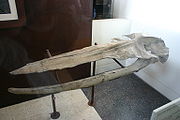
- Otradnocetus
- Palaeobalaena
- ParietobalaenaParietobalaenaParietobalaena is an extinct genus of baleen whale, belonging to the family Pelocetidae. Lived during the Miocene in North America, Europe, Australia and Japan....
- Pelocetus
- Peripolocetus
- Pinocetus
- Piscobalaena
- Plesiocetopsis
- Thinocetus
- Tiphyocetus
- Titanocetus
- Rhegnopsis
Family Cetotheriopsidae
(Oligocene to Miocene)- Cetotheriopsis
- Micromysticetus
Family Diorocetidae
(Miocene to Pliocene)- Amphicetus
- Diorocetus
- Plesiocetus
- Thinocetus
- Uranocetus
Family EschrichtiidaeEschrichtiidaeEschrichtiidae is a family of baleen whales in the suborder Mysticeti.At least five genera are recognised, but only a single species from one genus is still alive, the gray whale, Eschrichtius robustus....
(Miocene to Recent)
- Archaeschrichtius
- Eschrichtioides
- Eschrichtius (extant)
Family MammalodontidaeMammalodontidaeMammalodontidae is an extinct family of whales known from the Oligocene of Australia.There are currently two genera is this family: Janjucetus and Mammalodon. After a new cladistic analysis by Fitzgerald , Janjucetus was transferred into Mammalodontidae, thereby making Janjucetidae a junior synonym...
(jr synonym Janjucetidae)
- JanjucetusJanjucetusJanjucetus is an extinct genus of whale, and a basal form of the Mysticeti, a clade which includes the extant baleen whales. The only known species, Janjucetus hunderi, lived during the late Oligocene, about 25 million years ago in coastal seas off southeast Australia. Unlike modern mysticetes, it...
- MammalodonMammalodonMammalodon is an extinct genus of whale that was discovered in 1932. It is an early baleen whale which still had teeth, as opposed to baleen plates. It is one of two genera in the family Mammalodontidae....
Family PelocetidaePelocetidaePelocetidae is a extinct family of baleen whales. Existed during the Miocene in North America, Europe, Australia and Japan....
(Miocene)
- Cophocetus
- Halicetus
- ParietobalaenaParietobalaenaParietobalaena is an extinct genus of baleen whale, belonging to the family Pelocetidae. Lived during the Miocene in North America, Europe, Australia and Japan....
- Pelocetus
Family incertae sedisIncertae sedis , is a term used to define a taxonomic group where its broader relationships are unknown or undefined. Uncertainty at specific taxonomic levels is attributed by , , and similar terms.-Examples:*The fossil plant Paradinandra suecica could not be assigned to any...
- Amphitera
- Burtinopsis
- Eobalaenoptera (Middle Miocene; Mysticeti)
- Idiocetus (Late Miocene to Pliocene; Balaenoidea)
- Imerocetus (Late Miocene; Chaeomysticeti
- Mioceta
- Otradnocetus (Middle Miocene; Chaeomysticeti)
- Peripolocetus (Middle Miocene; Chaeomysticeti)
- Piscocetus (Pliocene; Chaeomysticeti)
- Siphonocetus
- Tiphyocetus (Miocene, Chaeomysticeti)
- Tretulias
- Ulias
Family Allodelphinidae
(Early to Middle Miocene)- Allodelphis
- Zarhinocetus
Family Delphinidae
(Oligocene to Recent)- Anacharsis
- Arimidelphis
- Astadelphis
- AustralodelphisAustralodelphisAustralodelphis is an extinct Pliocene genus of dolphin with a single described species, Australodelphis mirus. The genus is known from fossils found in the Sørsdal Formation, Vestfold Hills, East Antarctica...
- Delphinus (extant)
- Delphinus domeykoi
- Etruridelphis
- Globicephala (extant)
- Globicephala etruriae
- Globicephala karsteni
- Hemisyntrachelus
- Lagenorhynchus (extant)
- Lagenorhynchus harmatuki
- Orcinus (extant)
- Orcinus citoniensisOrcinus citoniensisOrcinus citoniensis is an extinct species of whale belonging to the family Delphinidae that lived from in the Pliocene.The species was related to the modern killer whale. Was described based on an incomplete skull found in Italy, which lacks the rear and left side, but had the back side. Had 14...
- Orcinus paleorca
- Orcinus citoniensis
- Protoglobicephala
- Pseudorca (extant)
- Pseudorca yokoyamai
- Stenella (extant)
- Stenella kabatensis
- Stenella rayi
- Tursiops (extant)
- Tursiops astensis
- Tursiops brochii
- Tursiops capellinii
- Tursiops oligodon
- Tursiops osennae
Family EurhinodelphinidaeEurhinodelphinidaeEurhinodelphinidae is an extinct family of toothed whales which lived from the Oligocene to the Pliocene. Members of the family possessed an elongated jaw similar in appearance to a swordfish.-Taxonomy:*Family Eurhinodelphinidae...
(Mid Miocene to Pliocene)
- Argyrocetus
- Ceterhinops
- EurhinodelphisEurhinodelphisEurhinodelphis is an extinct genus of Miocene cetacean. Its fossils have been found in France, Belgium, Maryland and California.-Description:...
- Iniopsis
- MacrodelphinusMacrodelphinusMacrodelphinus kelloggi was an orca-sized relative of the cetacean Eurhinodelphis. It lived off the coast of what is now California during the early Miocene. Because of its size, and inch-long teeth, it is believed to have been an apex predator. Macrodelphinus is known from a fragmentary skull...
- Mycteriacetus
- Phocaenopsis
- Rhabdosteus
- Schizodelphis
- Squaloziphius
- Vanbreenia
- Xiphiacetus
- Ziphiodelphis
Family KentriodontidaeKentriodontidaeKentriodontidae is an extinct family of odontocet whales related to modern dolphins. The Family lived from the Oligocene to the Pliocene before going extinct.-Taxonomy:...
(Late Oligocene - Middle Miocene)
- Subfamily Kentriodontinae
- Genus Belonodelphis
- Genus Delphinodon
- Genus Incacetus
- Genus KentriodonKentriodonKentriodon is an extinct species of toothed whale. Fossils have been found in Europe, Asia, New Zealand, and the United States.Kentriodon was the most diverse of all the kentriodontids, which include three named species and five undescribed species...
- Genus Macrokentriodon
- Genus Microphocaena
- Genus Rudicetus
- Genus Tagicetus
- Subfamily Lophocetinae
- Genus Hadrodelphis
- Genus Liolithax
- Genus Lophocetus
- Subfamily Pithanodelphininae
- Genus Atocetus
- Genus Leptodelphis
- Genus Pithanodelphis
- Genus Sophianacetus
- Subfamily incertae sedisIncertae sedis, is a term used to define a taxonomic group where its broader relationships are unknown or undefined. Uncertainty at specific taxonomic levels is attributed by , , and similar terms.-Examples:*The fossil plant Paradinandra suecica could not be assigned to any...
- Genus Sarmatodelphis
- Genus Kampholophos
Family Kogiidae
(Miocene to recent)- Aprixokogia
- Kogia (extant)
- Kogia pusilla
- KogiopsisKogiopsisKogiopsis is a genus of prehistoric sperm whales from the family Physeteridae. It lived in the mid Miocene. It was up to long. Kogiopsis had very long teeth, long, without root...
- Praekogia
- Scaphokogia
Family Odobenocetopsidae
(Pliocene)
- OdobenocetopsOdobenocetopsOdobenocetops was a small whale from the Pliocene. It had two tusks, and, in some fossils, one tusk was longer than the other.-Description:...
Family Phocoenidae
(Miocene to Recent)- Australithax
- Haborophocoena
- Lomacetus
- Loxolithax
- Numataphocoena
- Piscolithax
- Salumiphocaena
- Septemriocetus
Family Physeteridae
- AulophyseterAulophyseterAulophyseter is an extinct genus of sperm whale from the Miocene formations of the West and East coasts of North America as well as the Patagonian region of South America...
- Diaphorocetus
- Ferecetotherium
- Helvicetus
- Hoplocetus
- Idiophyseter
- Idiorophus
- OrycterocetusOrycterocetusOrycterocetus is an extinct genus of sperm whale from the Miocene.-Sources:* Cenozoic Seas: The View From Eastern North America by Edward J. Petuch* Marine Mammals: Evolutionary Biology by Annalisa Berta and James L. Sumich...
- Physeter (extant)
- Physeter antiquus
- Physeter vetus
- Physeterula
- Placoziphius
- Preaulophyseter
Family Platanistidae
(Miocene to Recent)- Araeodelphis
- Pachyacanthus
- Platanista (extant)
- Platanista croatica
- Pomatodelphis
- Prepomatodelphis
- Zarhachis
Family Pontoporiidae
(Middle Miocene to Recent)- Auroracetus
- Brachydelphis
- Pliopontos
- Pontistes
- Protophocaena
Fmaily Squalodelphinidae
(Early to Late Miocene)- Medocinia
- Notocetus (syn. Argyrodelphis, Diochotichus)
- Phocageneus
- Squalodelphis
Family Squalodontidae
(Oligocene to Pliocene)- Eosqualodon
- Phoberodon
- SqualodonSqualodonSqualodon is an extinct genus of whales, belonging to the family Squalodontidae. Named by Grateloup in 1840, it was originally believed to be an iguanodontid dinosaur but has since been reclassified. The name Squalodon comes from Squalus, a genus of shark...
(syn. Kelloggia, Rhizoprion, Crenidelphinus, Arionius, Macrophoca, Phocodon, Smilocamptus) - Tangaroasaurus
Family Xenorophidae
(Oligocene)- Albertocetus
- Archaeodelphis
- Xenorophus
Family Ziphiidae
(Miocene to Recent)- Africanacetus
- Archaeoziphius
- Anoplonassa
- Aporotus
- Beneziphius
- Belemnoziphius
- Caviziphius
- Cetorhynchus
- Choneziphius
- Eboroziphius
- Ihlengesi
- Izikoziphius
- Khoikhoicetus
- Mesoplodon (extant)
- Mesoplodon slangkopi
- Mesoplodon tumidirostris
- Messapicetus
- Microberardius
- Nazcacetus
- Nenga
- Ninoziphius
- Pelycorhamphus
- Pterocetus
- Xhosacetus
- Ziphirostrum
Family incertae sedisIncertae sedis , is a term used to define a taxonomic group where its broader relationships are unknown or undefined. Uncertainty at specific taxonomic levels is attributed by , , and similar terms.-Examples:*The fossil plant Paradinandra suecica could not be assigned to any...
- AcrophyseterAcrophyseterAcrophyseter is a genus of stem-sperm whales that lived around 6 million years ago.-Description:Acrophyseter is derived from the Greek akros, meaning acute, which describes the short, pointed upturned snout, and Physeter, the scientific name for sperm whales. But unlike today's sperm whales, A...
(Late Miocene; Physeteroidea) - Atropatenocetus (Oligocene; Odontoceti)
- Austrosqualodon (Oligocene; Odontoceti)
- BrygmophyseterBrygmophyseterBrygmophyseter is an extinct genus of toothed whale in the sperm whale family with one species Brygmophyseter shigensis. When first described, this species was placed in an extinct form genus Scaldicetus of toothed whale, as Scaldicetus shigensis)...
(Miocene; Physeteroidea) - Delphinavus (Miocene; DelphinoideaDelphinoideaDelphinoidea is the largest group of toothed whales with 66 genera in 6 families. The largest living member of the superfamily is the killer whale, which can reach 6 tonnes, while the smallest, Commerson's Dolphin, is also the smallest living cetacean....
) - Graamocetus (Miocene; Delphinoidea)
- Imerodelphis (Miocene; Odontoceti)
- Lamprolithax (Miocene; Delphinoidea)
- LivyatanLivyatan melvilleiLivyatan melvillei is an extinct species of physeteroid whale, which lived during the Miocene epoch, approximately 12-13 million years ago.- Discovery :...
(Miocene; Physeteroidea) - Miodelphis (Early Miocene; Delphinoidea)
- Nannolithax (Miocene; Delphinoidea)
- Oedolithax (Miocene; Delphinoidea)
- Oligodelphis (Oligocene; Delphinoidea)
- Palaeophocaena (Miocene; Delphinoidea)
- Placoziphius (Miocene; Physeteroidea)
- Platylithax (Miocene; Delphinoidea)
- Protodelphinus (Miocene; Delphinoidea)
- Saurocetus (Oligocene; Odontoceti)
- Scadicetus (Miocene; Physeteroidea)
- Sinanodelphis (Miocene; Delphinoidea)
- Thalassocetus (Miocene to Pliocene; Odontoceti)
- ZygophyseterZygophyseterZygophyseter varolai is an extinct cetacean, similar to the sperm whale. The common name of "killer sperm whale" refers both to its relation to modern day sperm whales, and to its similarity in size to and its "probable similar feeding adaptation to the extant delphinid killer whale ".The...
(Late Miocene; Physeteroidea)
See also
- Evolution of cetaceansEvolution of cetaceansThe cetaceans are marine mammal descendants of land mammals. Their terrestrial origins are indicated by:* Their need to breathe air from the surface;* The bones of their fins, which resemble the limbs of land mammals...
- List of cetaceans
- List of prehistoric mammals
- List of extinct animals

